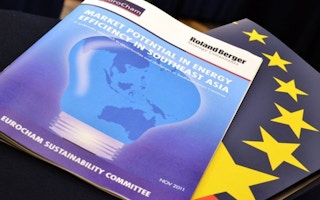The Southeast Asian market has great potential for increasing energy efficiency, but so far countries here are failing to take advantage of it.
A new study has found that by 2020, Southeast Asia could potentially increase overall energy efficiency by 12 to 30 per cent, resulting in savings of US$15 billion to US$43 billion.
The new report was launched on Thursday by global consultancy Roland Berger Strategy Consultants and the European Chamber of Commerce (Eurocham) at the Clean Energy Expo Asia in Singapore.
The study included five Asean countries - Indonesia, Malaysia, Singapore, Thailand and Vietnam - which together account for 86 per cent of Asean’s gross domestic product in 2010.
Roland Berger’s managing partner for Southeast Asia, Joost Geginat, told Eco-Business that the energy efficiency sector has identified a US$40 billion market in the region. Now the question is: how do they tap into that, he said.
Willi Hess, chairman of Eurocham’s sustainability committee, said that energy efficiency technology was vital to meeting future energy needs, given the rapidly rising demand and the shrinking fossil fuel resources.
“At the same time, it has a potential to benefit businesses by reducing costs to consumers, improve competitiveness and enhance overall productivity,” he noted.
The study’s authors note that while some progress has been made in Southeast Asia in energy efficiency, major barriers remain. These include insufficient policies and standards for energy management, mistrust and lack of communication between energy users and the suppliers, energy efficiency’s low ranking in business priorities, and a shortage of funding options for energy efficiency solutions.
According to the study, the answers lie in getting governments and companies to work together to raise awareness and capacity for increased energy efficiency in all sectors, including factories, power plants, households, office buildings, public buildings and retail malls.
Specifically, governments should provide a comprehensive range of policies that include mandatory and voluntary incentives to increase energy efficiency, and professional accreditation programmes that will ensure high industry standards.
The study also recommended that governments work with industry to integrate energy efficiency improvements at all levels, from power generation to household use. Part of this would entail setting up funding schemes to boost energy efficiency financing.
Mr Geginat noted in a statement that the private sector should do their part too. “Private sectors need to be more pro-active in developing the energy efficiency market,” he said.
One industry player trying to do that is global energy services firm Schneider Electric. Speaking to Eco-Business on the sidelines of the Clean Energy Expo Asia, Schneider Electric vice president Jane Goh, noted that as power costs rise, growing numbers of large energy consumers, such as leading property developers and multi-national corporations, are willing to spend to reduce their escalating electricity bills.
These companies, in addition to those committed to improving sustainability and transparency in their operations, are the main drivers of energy efficiency within the building industry, said Ms Goh.
It helps that government regulations are imposing stricter standards on building owners. But companies do not need to wait for a major renovation or equipment replacement to significantly improve their building’s energy efficiency.
Building design and equipment are only part of the solution, explained Ms Goh, adding that once a building is operational, it is up to the building manager to keep operating costs low and make sure resources are used efficiently.
This is where Schneider comes in, she said, adding that the firm has helped clients save up to 30 per cent on energy costs by overhauling the way they manage energy consuming systems such as lighting, air-conditioning, IT networks, security systems, production equipment and lifts.
The firm often works with companies on an organisation-wide basis, meaning that energy management for multiple sites including offices, factories and other facilities can be rolled into one location.
After auditing a company’s energy patterns and consumption, Schneider identifies ways of reducing operating costs through more efficient electricity and staff management. This often entails automating the different buildings systems under the control of a single software programme.
Under this system, energy managers can access data instantly on a single monitor and be alerted to any problems immediately. This means building managers can do their jobs more effectively, and building occupants have more peace of mind, noted Ms Goh.
Eliminating wasted energy through automated lighting alone can save up to 10 per cent in energy consumption, she said, and savings such as these mean that companies can recoup their energy saving investments within one to three years.
The company is also looking at ways to get building occupants more involved in the energy management efforts by increasing visibility and transparency, a process Ms Goh said may very well lead to tenants getting a share of energy costs savings.
Active metering through building management software systems, which provides feedback to energy managers and building occupants on their energy consumption, allows energy users to be involved in the energy conservation process, she noted.
Roland Berger’s Mr Geginat agreed that multi-nationals have an additional role.
“Multinationals can act as catalysts by applying the same guidelines for energy utilisation and ensuring that best practices are adopted across their international operations. These companies can set the standard in energy efficiency for their industries and acting as role models in Southeast Asia,” he said.















